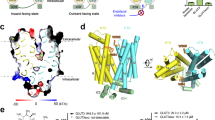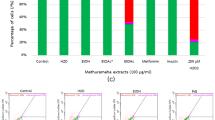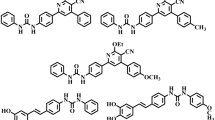Abstract
Methylxanthines such as caffeine and theophylline are known to inhibit glucose transport. We have studied such inhibition in the glucose transporter type 1 deficiency syndrome (Glut1DS) by erythrocyte glucose transport assays. Data from four patients with individual mutations in the GLUT1 gene are discussed: patient 1 (hemizygosity), 3 (S66F), 15 (368Ins23), and 17 (R333W). Zero-trans influx of 14C-labeled 3-O-methyl glucose (3-OMG) into erythrocytes of patients is reduced (patient 1, 51%; 3, 45%; 15, 31%; 17, 52%) compared with maternal controls. Inhibition studies on patients 1, 3, 17, and maternal controls show an IC50 for caffeine of approximately 1.5 mM both in controls (n = 3) and patients (n = 3) at 5 mM 3-OMG concentration. In the same two groups, kinetic studies show that 3 mM caffeine significantly decreases Vmax (p < 0.005), whereas the decrease in Km is significant (p < 0.01) only in the three controls and one patient (patient 3). Kinetic data from individual patients permit us to speculate that the interactions between caffeine and Glut1 are influenced by the mutation. Three mM caffeine also inhibits the transport of dehydroascorbic acid (DHA), another substrate for Glut1. The combined effects of caffeine (3 mM) and phenobarbital (10 mM) on glucose transport, as determined in patient 15 and the maternal control, show no additive or synergistic inhibition. These data indicate that caffeine and phenobarbital have similar Glut1 inhibitory properties in these two subjects. Our study suggests that Glut1DS patients may have a reduced safety margin for methylxanthines. Consumption of methylxanthine-containing products may aggravate the neurologic symptoms associated with the Glut1DS.
Similar content being viewed by others
Log in or create a free account to read this content
Gain free access to this article, as well as selected content from this journal and more on nature.com
or
Abbreviations
- DHA:
-
dehydroascorbic acid
- GLUT1:
-
facilitated glucose transporter type 1 gene
- Glut1:
-
facilitated glucose transporter type 1 protein
- Glut1DS:
-
glucose transporter type 1 deficiency syndrome
- 3-OMG:
-
3-O-methyl-D-glucose
- >Vmax:
-
maximal transport velocity
- >Km:
-
substrate affinity
References
Pardridge WM, Boado RJ, Farrell CR 1990 Brain-type glucose transporter (Glut-1) is selectively localized to the blood-brain barrier. J Biol Chem 265: 18035–18040
Baldwin SA 1993 Mammalian passive glucose transporters: members of active and passive transport proteins. Biochim Biophys Acta 1154: 17–49
Bell IG, Burant CF, Takeda J, Gould GW 1993 Structure and function of mammalian facilitative sugar transporters. J Biol Chem 268: 19161–19164
Gould GW, Holman GD 1993 The glucose transporter family: structure, function, and tissue-specific expression. Biochem J 295: 329–341
Seidner G, Garcia-Alvarez M, Yeh JI, O'Driscoll KR, Klepper J, Stump TS, Wang D, Spinner NB, Birnbaum MJ, De Vivo DC 1998 Glut-1 deficiency syndrome caused by haploinsufficiency of the blood-brain barrier hexose carrier. Nat Genet 18: 1–4
De Vivo DC, Trifiletti RR, Jacobson RI, Ronen GM, Behmand RA, Harik SI 1991 Defective glucose transport across the blood-brain barrier as a cause of persistent hypoglycorrhachia, seizures, and developmental delay. N Engl J Med 325: 703–709
De-Vivo DC, Garcia-Alvarez M, Ronen G, Trifiletti R 1995 Glucose transport protein deficiency: an emerging syndrome with therapeutic implications. Int Ped 10: 51–56
Klepper J, Wang D, Fischbarg J, Vera JC, Jarjour IT, O'Driscoll KR, De Vivo DC 1999 Defective glucose transport across brain tissue barriers: a newly recognized neurological syndrome. Neurochem Res 24: 587–594
Wang D, Kranz-Eble P, De Vivo DC 2000 Mutational analysis of the GLUT1 (SLC2A1) in Glut-1 deficiency syndrome. Hum Mutat 16: 224–231
Ho YY, Wang D, De Vivo DC 2001 Glucose transporters. In: The Encyclopedia of Molecular Medicine. John Wiley & Sons Publishing, New York (in press)
Challiss JRA, Taylor LP, Holman GD 1980 Sugar transport asymmetry in human erythrocytes—the effect of bulk haemoglobin removal and the addition of methylxanthines. Biochem Biophys Acta 602: 155–166
Steinfelder HJ, Petho-Schramm S 1990 Methylxanthines inhibit glucose transport in rat adipocytes by two independent mechanisms. Biochem Pharmacol 40: 1154–1157
Yasuhara M, Levy G 1988 Caffeine as a potential risk factor for theophylline neurotoxicity. J Pharm Sci 77: 745–747
Ault B, Olney MA, Joyner JL, Boyer CE, Notrica MA, Soroko FE, Wang CM 1987 Pro-convulsant actions of theophylline and caffeine in the hippocampus: implications for the management of temporal lobe epilepsy. Brain Res 426: 93–102
Moraidis I, Bingmann D 1994 Epileptogenic actions of xanthines in relation to their affinities for adenosine A1 receptors in CA3 neurons of hippocampal slices. Brain Res 640: 140–145
Biaggioni I, Puckett PS, Arzubiaga C 1991 Caffeine and theophylline as adenosine receptor antagonists in humans. J Pharmacol Exp Ther 258: 588–593
Dassesse D, Vanderwinden JM, Goldberg I, Vanderhaeghen JJ, Schiffmann SN 1999 Caffeine-mediated induction of c-fos, zif-268, and arc expression through A1 receptors in the striatum: different interactions with the dopaminergic system. Eur J Neurosci 11: 3101–3114
Klepper J, Fischbarg J, Vera JC, Wang D, De Vivo DC 1999 GLUT1 deficiency: barbiturates potentiate haploinsufficiency in vitro. Pediatr Res 46: 677–683
Klepper J, Garcia-Alvarez M, O'Driscoll KR, Parides MK, Wang D, Ho YY, De-Vivo DC 1999 Erythrocyte 3-O-methyl-d-glucose uptake assay for diagnosis of glucose-transporter-protein syndrome. J Clin Lab Anal 13: 116–121
Naftalin RJ, Holman GD 1977 Transport of sugars in human red cells. In: Ellory JC, Lew VL (eds) Membrane Transport in Red Cells. Academic Press, New York, pp 257–300
Klepper J, Vera JC, De-Vivo DC 1998 Deficient transport of dehydroascorbic acid in the glucose transporter protein syndrome. Ann Neurol 44: 286–287
Rumsey SC, Kwon O, Xu GW, Burant CF, Simpson I, Levine M 1997 Glucose transporter isoforms GLUT1 and GLUT3 transport dehydroascorbic acid. J Biol Chem 272: 18982–18989
Chugani HT, Phelps ME, Mazziotta JC 1978 Positron emission tomography study of human brain functional development. Ann Neurol 22: 487–497
Clarke DD, Sokoloff L 1999 Circulation and energy metabolism of the brain. In: Siegel GJ (ed) Basic Neurochemistry: Molecular, Cellular, and Medical Aspects, 16th Ed. Raven Press, New York, pp 645–748
Vannucci SJ, Maher F, Simpson IA 1997 Glucose transporter proteins in brain: delivery of glucose to neurons and glia. Glia 21: 2–21
Kashiwagi A, Huecksteadt TP, Foley JE 1983 The regulation of glucose transport by c-AMP stimulators via three different mechanisms in rat and human adipocytes. J Biol Chem 258: 13685–13692
Pascual JM, Wang D, Kuang K, Yang H, Wen Q, Ma L, Fischbarg J, De Vivo DC 2000 Transport properties of disease-causing GLUT1 mutations. Carden Jennings Publishing, Charlottesville, VA, Society of Neuroscience Conference 26: 814( abstr)
Dick APK, Harik SI, Klip A, Walker DM 1984 Identification and characterization of the glucose transporter of the blood/brain barrier by cytochalasin-B binding and immunological reactivity. Proc Natl Acad Sci USA 81: 7233–7237
Sarro AD, Grasso S, Zappala M, Nava F, De Sarro G 1997 Convulsant effects of some xanthine derivatives in genetically epilepsy-prone rats. Arch Pharmacol 356: 48–55
Rall TW 1985 Central nervous stimulants. In: Gilman AG, Goodman LS, Rall TW, Murad F (eds) The Pharmacological Basis of Therapeutics. McMillan Publishers Company, New York, pp. 589–603
Acknowledgements
The authors thank Pamela Kranz-Eble for skillful assistance in the laboratory and David Diuguid, M.D., Hematology Laboratory, Columbia Presbyterian Medical Center, for blood cell counts. CPD anticoagulant solution was generously provided by Baxter Healthcare Corporation, Fenwal Division, Deerfield, IL 60014, U.S.A.
Author information
Authors and Affiliations
Corresponding author
Rights and permissions
About this article
Cite this article
Ho, YY., Yang, H., Klepper, J. et al. Glucose Transporter Type 1 Deficiency Syndrome (Glut1DS): Methylxanthines Potentiate GLUT1 Haploinsufficiency In Vitro. Pediatr Res 50, 254–260 (2001). https://doi.org/10.1203/00006450-200108000-00015
Received:
Accepted:
Issue date:
DOI: https://doi.org/10.1203/00006450-200108000-00015
This article is cited by
-
Tune in to the terrific applications of turanose
European Food Research and Technology (2024)
-
Natural Products and Derivatives Targeting at Cancer Energy Metabolism: A Potential Treatment Strategy
Current Medical Science (2020)
-
Crystal structure of a bacterial homologue of glucose transporters GLUT1–4
Nature (2012)
-
Interactions of androgens, green tea catechins and the antiandrogen flutamide with the external glucose‐binding site of the human erythrocyte glucose transporter GLUT1
British Journal of Pharmacology (2003)



